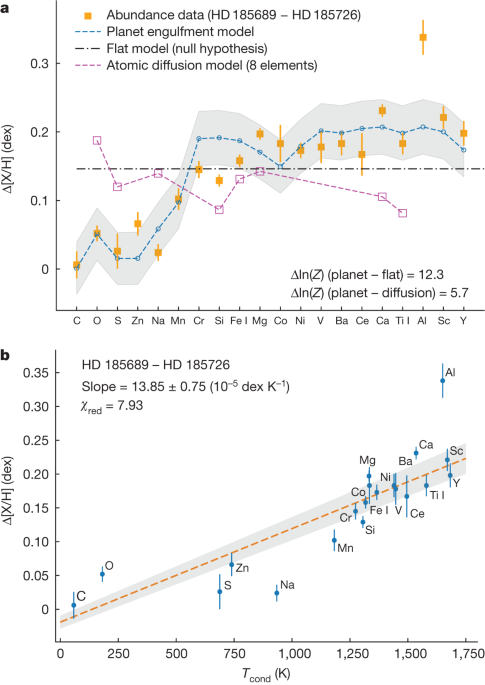Core Concepts
Stellar chemical compositions can be altered by the ingestion of planetary material, providing evidence of planet signatures and deepening our understanding of the star-planet-chemistry connection.
Abstract
Introduction:
Stellar chemical compositions can change due to planetary ingestion or planet formation.
Detecting planet signatures is challenging due to various factors like occurrence rates and heterogeneous star samples.
Methodology:
Gaia satellite offers opportunities for detecting stellar chemical signatures among co-natal pairs of stars.
High-precision chemical abundances were reported for ninety-one co-natal pairs, revealing instances of planetary ingestion.
Findings:
Seven instances of planetary ingestion were identified, with an occurrence rate of eight percent.
An independent Bayesian indicator helped distinguish planet signatures from other factors.
Conclusion:
The study provides evidence of planet signatures and enhances our understanding of the mechanisms behind planet engulfment, formation, and evolution.
At least one in a dozen stars shows evidence of planetary ingestion - Nature
Stats
An occurrence rate of eight percent was identified for planetary ingestion.
Quotes
Key Insights Distilled From
by Fan Liu,Yuan... at www.nature.com 03-20-2024
https://www.nature.com/articles/s41586-024-07091-y
Deeper Inquiries
How does the identification of planetary ingestion in stars impact our understanding of exoplanet formation
The identification of planetary ingestion in stars significantly impacts our understanding of exoplanet formation by providing direct observational evidence of the processes involved. By detecting planet signatures through correlations between elemental abundance differences and dust condensation temperatures, we can infer the presence of planets around these stars. This information sheds light on how planets form, evolve, and interact with their parent stars. The occurrence rate of planetary ingestion, as revealed in this study to be eight percent among co-natal pairs of stars, offers insights into the frequency at which such events occur in stellar systems. Understanding these mechanisms is crucial for developing comprehensive models of exoplanet formation scenarios.
What are the implications for future studies on stellar chemical compositions based on these findings
The findings regarding planetary ingestion among co-natal pairs of stars have significant implications for future studies on stellar chemical compositions. By identifying at least seven instances of planetary ingestion within a sample group using high-precision chemical abundances and Bayesian indicators to distinguish planet signatures from other factors, researchers can refine their understanding of how planets influence the composition of their host stars. This opens up avenues for more targeted investigations into the star–planet–chemistry connection and provides observational constraints that can validate theoretical models related to planet engulfment, formation, and evolution. Future studies can build upon these results to explore a wider range of stellar samples and investigate additional factors influencing stellar chemistry.
How can advancements in technology further improve the detection and analysis of planet signatures in stars
Advancements in technology offer promising opportunities to further improve the detection and analysis of planet signatures in stars. Instruments with higher precision spectroscopy capabilities can enhance our ability to measure chemical abundances accurately across different elements present in stellar atmospheres. Additionally, developments in data processing techniques enable researchers to handle large datasets efficiently and extract relevant information effectively from observations obtained by instruments like the Gaia satellite14 mentioned in the context above. Machine learning algorithms could also be employed to automate the identification process for planet signatures based on predefined criteria derived from known patterns observed in stellar spectra. Collaborative efforts between astronomers specializing in exoplanets, stellar evolution, and computational methods will be essential for leveraging technological advancements towards advancing our knowledge about star–planet interactions through chemical analyses.
0
